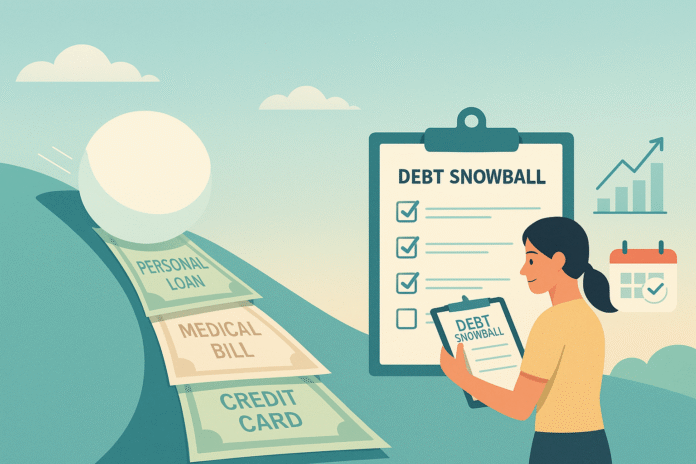If your debts feel like a tangled knot, the debt snowball strategy gives you a simple way to pull the first thread and keep going until the knot disappears. In this guide, you’ll learn how to prioritize your debts, set up a realistic budget, choose the right order of payoffs, and build momentum using the debt snowball method. We’ll cover practical steps, common pitfalls, tools, and a four-week starter plan so you can begin today with clarity and confidence.
Disclaimer: This article is for general education only and not financial advice. Debt situations vary. Consider speaking with a qualified financial professional or accredited credit counselor for personalized guidance.
Key takeaways
- Debt snowball = smallest balance first. You make minimum payments on everything, then focus extra cash on your smallest debt.
- Momentum matters. Early wins boost motivation, which helps you stick to the plan long enough to finish.
- Order is deliberate. Special cases—like secured loans, tax debts, and accounts in collections—need careful handling alongside your snowball.
- Automate and track. Autopay minimums, schedule snowball payments, and use simple metrics to see progress fast.
- Have a plan for detours. Build a small buffer, troubleshoot setbacks quickly, and know when to consider credit counseling or a debt management plan.
Understand the Debt Snowball Strategy
What it is and the core benefits
The debt snowball strategy prioritizes paying off debts from the smallest balance to the largest, regardless of interest rate. You make minimum payments on all accounts, put every extra dollar on the smallest debt until it’s gone, and then roll that old payment into the next-smallest balance. The result is a growing “snowball” payment that gathers speed as you go.
Why it works: progress is visible early. Clearing an entire debt—no matter how small—creates a psychological win that increases follow-through. Over months, these wins string together into durable momentum.
Requirements and low-cost alternatives
- What you need:
- A list of debts (credit cards, personal loans, medical bills, etc.) with balances, minimum payments, interest rates, and due dates.
- A monthly budget and a small buffer for surprises.
- A checking account that supports autopay and scheduled transfers.
- Low-cost alternatives:
- A simple spreadsheet or notebook.
- Free calculators and payoff planners available online.
Step-by-step for beginners
- List all debts with balances and minimums.
- Sort by balance (smallest to largest); ignore interest rates for the snowball order.
- Pay minimums on every debt.
- Target extra cash to the smallest balance until it’s paid off.
- Roll that payment to the next-smallest debt, repeating the cycle.
Beginner modifications and progressions
- If cash is tight: start with a micro-snowball—an extra $10–$25 per pay period—just to build the habit.
- Ready to accelerate: add windfalls (tax refunds, bonuses, side-income) directly to the current snowball target.
Recommended frequency, duration, and metrics
- Frequency: make snowball payments every payday or monthly—consistency beats size.
- Duration: depends on total debt and snowball amount; the key is steady month-over-month principal reduction.
- Metrics:
- Number of accounts closed.
- Total debt balance trend (down monthly).
- Snowball size (growing as each debt disappears).
Safety, caveats, and common mistakes
- Always pay minimums to avoid late fees and credit damage.
- Don’t ignore secured debts (car loans, mortgages) or priority debts (taxes, child support).
- Avoid new debt while snowballing—press pause on new credit.
Mini-plan example (2–3 steps)
- Move $50 of non-essentials into your snowball.
- Apply it to the smallest debt for two pay cycles.
- When it’s gone, add its old minimum payment to your snowball and move to the next.
Prepare Your Financial Baseline
What it is and why it matters
A baseline captures where your money stands today—what you owe, what you earn, and what you spend. Without it, prioritization is guesswork. With it, your snowball becomes a precise, targeted plan.
Requirements and low-cost alternatives
- What you need: last 1–3 months of statements (bank, credit card, loans), pay stubs, and bills.
- Tools: a spreadsheet, a budgeting app, or pen-and-paper.
Step-by-step for beginners
- Income snapshot: list all after-tax income by pay date.
- Fixed bills: rent, utilities, insurance—record dates and amounts.
- Variable spending: groceries, transport, discretionary—average the last three months.
- Debt inventory: for each account write balance, minimum, interest rate, and due date.
- Cash buffer: set aside a small emergency cushion so surprises don’t derail payments.
Beginner modifications and progressions
- Short on time: start with only debts and income; layer in spending details later.
- Level up: tag expenses (needs vs. wants) to locate easy savings for your snowball.
Metrics and cadence
- Refresh monthly after statements cut.
- Track two lines: total debt and cash buffer.
Safety checks and common mistakes
- Don’t skip accounts. Small medical or store-card balances often wreck budgets if forgotten.
- Watch due dates. Stagger payments to your pay cycle so you don’t overdraft.
Mini-plan example
- Download last month’s statements.
- Fill a one-page debt inventory.
- Schedule minimums for each due date.
Build a Practical Budget and Find Your Snowball Money
What it is and core benefits
Your budget is the engine that powers the snowball. It creates predictable cash flow and identifies money you can reassign from low-value spending into debt payoff.
Requirements and low-cost alternatives
- Needs: a simple monthly plan with categories for income, fixed bills, debt minimums, essentials, and a small buffer.
- Low-cost: free budget templates or a printable one-pager; a phone reminder for weekly check-ins.
Step-by-step for beginners
- Start from take-home pay. Map each pay date to that period’s bills and minimums.
- Separate needs and wants. Protect housing, utilities, food, transport, and insurance.
- Set a small buffer for irregular expenses (gifts, fees, repairs).
- Choose your snowball amount. This is your surplus after needs, minimums, and buffer.
- Automate transfers to a separate “snowball” sub-account on payday.
Beginner modifications and progressions
- If income varies: budget using last month’s average income; treat any extra as bonus snowball.
- Progression: sweep all “found money” (refunds, cashback, selling unused items) to your snowball account the day it arrives.
Frequency, duration, and metrics
- Weekly 10-minute review to confirm autopays, check balances, and adjust the snowball amount.
- Metrics: on-time payment rate, snowball dollars this month, and discretionary spend vs. plan.
Safety and common mistakes
- Over-restricting essentials backfires—budget realistically.
- Zero buffer = fragile plan. Even a tiny cushion prevents missed payments after small surprises.
Mini-plan example
- Cut one discretionary category by a modest amount.
- Move that amount to your snowball sub-account each payday.
- Review after 30 days and adjust.
Order Your Debts the Right Way
What it is and purpose
Prioritization is the heart of the snowball. You’ll rank debts by smallest balance to largest while handling sensitive debt types appropriately.
Requirements and low-cost alternatives
- Needs: complete debt list with balances and types (credit card, personal loan, medical, student loan, auto, tax, etc.).
- Low-cost: a sortable spreadsheet or index cards you can reorder on a table.
Step-by-step for beginners
- Label special categories: secured debts (car, mortgage), priority debts (taxes, child support), and debts in collections.
- List all other debts and sort by balance (smallest to largest).
- Set the payment plan:
- Minimums on every debt.
- Snowball target = smallest balance that is not a priority/secured exception.
- Make an exceptions plan:
- Secured debts: don’t underpay and risk repossession/foreclosure.
- Priority debts: follow official payment plans; these often take precedence.
- Collections/charged-off debts: verify the debt, understand local rules, and consider negotiating or including them in a counseling plan.
Beginner modifications and progressions
- If a tiny balance is only a few payments away: move it to the top for a quick win.
- If a balance has a due-soon promotional rate expiring: consider prioritizing before a rate jump, even if it breaks strict balance order.
Frequency, duration, metrics
- Re-order if needed when you pay off a debt or a balance/rate changes materially.
- Metric: number of accounts remaining and expected payoff month for the current target.
Safety, caveats, common mistakes
- Do not ignore legal/priority obligations.
- Don’t juggle minimums—on-time minimums are non-negotiable.
- Be cautious about settling debts without knowing tax and credit implications.
Mini-plan example
- Flag secured and priority debts.
- Sort the remaining by smallest balance.
- Circle your first snowball target and set the extra payment amount.
Automate and Execute the Snowball
What it is and core benefits
Execution turns your plan into results. Automation reduces missed payments and mental load, making consistency easy.
Requirements and low-cost alternatives
- Needs: online bill pay or autopay options, ability to schedule recurring transfers, and phone calendar reminders.
- Low-cost: bank’s free autopay, or a shared calendar with alarms.
Step-by-step for beginners
- Autopay every minimum. Set for 3–5 days before each due date.
- Schedule a recurring snowball payment on payday to the current target debt.
- Create a “rollover ritual.” When a debt is paid off, the same day redirect its minimum to the next debt.
- Windfall rule: any non-budgeted income goes 100% to the snowball target within 24 hours.
Beginner modifications and progressions
- If you’re nervous about autopay: begin with calendar reminders and manual payments for a month, then switch to autopay once confident.
- Progression: add a mid-month micro-payment to your current target to compound progress.
Frequency, duration, metrics
- Weekly five-minute check-in to confirm successful autopays.
- Metrics: payment success (100% on time), snowball dollars sent this month, principal reduced.
Safety and common mistakes
- Avoid overdrafts. Align autopays with your pay dates and maintain a small buffer.
- Don’t forget to stop autopay on a paid-off account and redirect the amount to the next target.
Mini-plan example
- Turn on autopay minimums today.
- Schedule a recurring payday snowball transfer.
- Add a reminder titled “Rollover to Next Debt” for the expected payoff date.
Handle Exceptions: Collections, Tax Debts, and Secured Loans
What these are and why they matter
Not all debts behave the same. Some carry legal or collateral risks. Others have negotiation potential. Handling them wisely prevents costly detours.
Requirements and low-cost alternatives
- Needs: a clear list of any debts in collections or with legal/priority status.
- Low-cost help: reputable nonprofit credit counseling for guidance and potential debt management plans (DMPs).
Step-by-step for beginners
- Verify collection accounts. Request validation when appropriate and keep records.
- For tax or legal obligations, follow official payment guidance or arrange a formal plan.
- For secured debts, protect on-time payments—repossession or foreclosure is far more damaging than an extra month on a credit card payoff.
- Consider counseling. If you’re overwhelmed or facing high rates across several cards, a DMP through a nonprofit counselor may consolidate payments and potentially reduce rates with participating creditors.
Beginner modifications and progressions
- If you can’t meet all minimums: immediately contact creditors or a nonprofit counselor to discuss temporary hardship options.
- If you’re stable: continue the snowball while keeping priority and secured debts pristine.
Frequency, duration, metrics
- Monthly review of any special accounts until they’re resolved.
- Metrics: number of accounts removed from collections, on-time payment record for secured/priority debts.
Safety, caveats, mistakes
- Beware of for-profit “quick fixes.” Understand fees and long-term consequences before enrolling in any program.
- Document every agreement with collectors or agencies.
- Get advice if you’re considering settlement or bankruptcy—each choice has serious trade-offs.
Mini-plan example
- Make secured/priority minimums non-negotiable.
- Contact any collector in writing to verify details.
- Book a free intake call with a nonprofit counselor if minimums are at risk.
Tools, Templates, and Low-Cost Alternatives
What this covers and why it helps
Small frictions derail great plans. Simple tools remove friction, show progress, and protect your time.
Requirements and low-cost options
- Spreadsheets: a one-tab payoff tracker listing debt name, balance, minimum, due date, and “status.”
- Calculators: payoff timelines and snowball/avalanche comparisons.
- Banking tools: autopay, sub-accounts or “vaults,” alerts.
- Low-cost: free online calculators, printable trackers, or index cards clipped together.
Step-by-step for beginners
- Pick one tracker—spreadsheet or paper—and keep it visible.
- Set automated alerts for due dates and low balances.
- Use a simple payoff calculator to preview your timeline and motivate action.
Beginner modifications and progressions
- If apps overwhelm you: stick with paper plus bank autopay.
- If you like data: build a dashboard that graphs total balance and number of accounts remaining.
Frequency, duration, metrics
- Update weekly with new balances.
- Metrics: debts paid off since start, snowball payment size trend, and estimated payoff date.
Safety and common mistakes
- Tool hopping wastes time—choose one system and commit for 90 days.
- Don’t store passwords in plain text in your tracker.
Mini-plan example
- Download a one-page tracker.
- List all debts and due dates.
- Bookmark a payoff calculator and test snowball vs. avalanche for motivation.
Measure Progress and Stay Motivated
What it is and core benefits
Motivation is renewable when you see progress. Intentional tracking turns distant goals into daily wins.
Requirements and low-cost alternatives
- Needs: a visible progress bar, debt-free thermometer, or checklist of accounts.
- Low-cost: a paper tracker on your fridge or a lock screen note on your phone.
Step-by-step for beginners
- Create a visual of your total debt and fill it in as balances drop.
- Name milestones (first $500 paid, first account closed, 25% debt-free mark).
- Celebrate modestly after each milestone—free or low-cost rewards only.
Beginner modifications and progressions
- If you’re discouraged: shorten the horizon—focus only on the current account’s next $100 of principal.
- If you’re energized: add a side hustle or overtime with a clear end date and purpose.
Frequency, duration, metrics
- Weekly update your tracker.
- Metrics: milestone count, accounts closed, and months ahead of your original timeline.
Safety, caveats, mistakes
- Avoid reward splurges that undo progress.
- Don’t compare your timeline to others—debt mixes differ.
Mini-plan example
- Print a thermometer tracker.
- Color in the first segment after your next payment.
- Schedule a free mini-celebration (home movie night) when you close the first account.
Troubleshooting & Common Pitfalls
Frequent issues and quick fixes
- “I keep missing due dates.”
Fix: Turn on autopay for minimums and set reminders 7 and 3 days before each due date. - “Unexpected bills keep breaking my plan.”
Fix: Add a small buffer line to your budget and temporarily reduce your snowball amount until you rebuild it. - “One high-rate card feels dangerous to ignore.”
Fix: Keep snowball order but send a small extra to that card for peace of mind, or temporarily switch to avalanche if anxiety is derailing you. - “Income varies and I overcommit.”
Fix: Base your plan on last month’s income average. Treat any extra as bonus snowball, never as assumed cash. - “I feel like I’m not getting anywhere.”
Fix: Track principal paid this month and the number of accounts closed—wins are easier to see than total dollars. - “I’m overwhelmed by collections.”
Fix: Verify debts, know your rights, and consider nonprofit credit counseling to coordinate payments.
Mini-plan example
- Identify the single biggest friction (missed due date, surprise bill, etc.).
- Apply the corresponding fix for the next 30 days.
- Reassess and iterate—only change one thing at a time.
Quick-Start Checklist
- List every debt with balance, minimum, rate, and due date.
- Mark secured/priority/collections accounts.
- Sort remaining debts by smallest balance first.
- Choose your snowball amount from a realistic budget.
- Turn on autopay for all minimums.
- Schedule your snowball payment on payday.
- Create a rollover ritual for when a debt is paid off.
- Put a visual tracker where you’ll see it daily.
- Set a monthly review to update balances and celebrate progress.
4-Week Starter Plan (Simple Roadmap)
Week 1 – Inventory & Setup
- Gather statements and list debts.
- Identify secured, priority, and collection accounts.
- Sort the rest by smallest balance.
- Turn on autopay for minimums.
- Open a sub-account titled “Snowball” and schedule your first payday transfer.
Week 2 – Budget & Buffer
- Draft a basic budget anchored to your pay cycle.
- Add a small buffer line to absorb surprises.
- Decide your starting snowball amount and schedule it.
- Print or set up a one-page payoff tracker.
Week 3 – Execute & Track
- Make your first snowball payment to the smallest balance.
- Color in your progress tracker.
- Look for one painless expense cut and redirect the savings to your snowball.
Week 4 – Review & Adjust
- Update balances and confirm autopays.
- If the first debt is nearly paid, plan the rollover date now.
- Reflect on what worked, adjust the snowball amount if possible, and recommit for the next month.
Frequently Asked Questions
1) What’s the difference between the debt snowball and the avalanche?
Snowball targets smallest balances first to build momentum. Avalanche targets highest interest rates first to minimize total interest. Both require paying minimums on all accounts.
2) Which method should I choose if I’m very motivated by numbers?
If you’ll stick with a plan no matter what, avalanche often reduces interest costs faster. If you need early wins to stay engaged, snowball can be more sustainable.
3) Can I switch from snowball to avalanche later?
Yes. Many people start with snowball to get traction, then switch once only a few debts remain.
4) What if one debt is secured (like a car loan)?
Keep secured debts current to avoid loss of the asset. If necessary, treat them as protected payments while you snowball other balances.
5) How big should my emergency buffer be before I start?
Even a small cushion helps prevent missed payments. Start with something manageable and grow it gradually as you pay down debt.
6) What about debts in collections or old medical bills?
Verify details, keep records, and consider negotiating a written plan. If you’re unsure, seek guidance from a reputable nonprofit credit counselor.
7) How do I keep from getting discouraged?
Track visible wins: accounts closed, principal paid this month, and your growing snowball amount. Celebrate small milestones in low-cost ways.
8) Will the snowball method hurt my credit score?
Paying on time is key. As balances fall and accounts close in good standing, many people see improvement over time. Your results depend on your broader credit use.
9) Should I consolidate my debts first?
Consolidation can simplify payments but isn’t always cheaper or safer. Compare total costs and terms carefully. If consolidation tempts overspending, stick with the snowball.
10) When should I seek professional help?
If you can’t meet minimums, creditors are calling, or you feel stuck, connect with a nonprofit credit counselor. They can review options and, if appropriate, discuss a debt management plan.
Conclusion
The debt snowball strategy turns a complicated financial puzzle into a series of simple wins. Prioritize your debts by smallest balance, protect your minimums, automate your payments, and measure progress you can see. With consistent action—week after week—you’ll move from overwhelm to control, and from control to freedom.
Start now: make your first snowball payment today and schedule the rollover to your next debt. One decisive step, then another.
References
- Debt Snowball Method: How It Works to Pay Off Debt — Investopedia — (accessed and current) — https://www.investopedia.com/terms/s/snowball.asp
- How to reduce your debt — Consumer Financial Protection Bureau — July 16, 2019 — https://www.consumerfinance.gov/about-us/blog/how-reduce-your-debt/
- Lowering your debt (toolkit) — Consumer Financial Protection Bureau — August 2021 — https://files.consumerfinance.gov/f/documents/cfpb_lowering-your-debt_tool_2021-08.pdf
- How To Get Out of Debt — Federal Trade Commission — (accessed and current) — https://consumer.ftc.gov/articles/how-get-out-debt
- Coping With Debt (PDF) — Federal Trade Commission — (accessed and current) — https://consumer.ftc.gov/sites/default/files/articles/pdf/pdf-0037-coping-with-debt.pdf
- Debt Snowball Method: How It Works, When to Use It — NerdWallet — May 6, 2025 — https://www.nerdwallet.com/article/finance/what-is-a-debt-snowball
- What Is a Debt Management Plan? — National Foundation for Credit Counseling — (accessed and current) — https://www.nfcc.org/resources/debt-management-plans/
- How a Debt Management Plan Works — Money Management International — (accessed and current) — https://www.moneymanagement.org/debt-management/how-a-debt-management-plan-works
- Debt Avalanche vs. Debt Snowball: What’s the Difference? — Investopedia — (accessed and current) — https://www.investopedia.com/articles/personal-finance/080716/debt-avalanche-vs-debt-snowball-which-best-you.asp
- The Power of Small Wins — Harvard Business Review — May 2011 — https://hbr.org/2011/05/the-power-of-small-wins
- What to know about the debt snowball vs. avalanche method — Wells Fargo — (accessed and current) — https://www.wellsfargo.com/goals-credit/smarter-credit/manage-your-debt/snowball-vs-avalanche-paydown/






